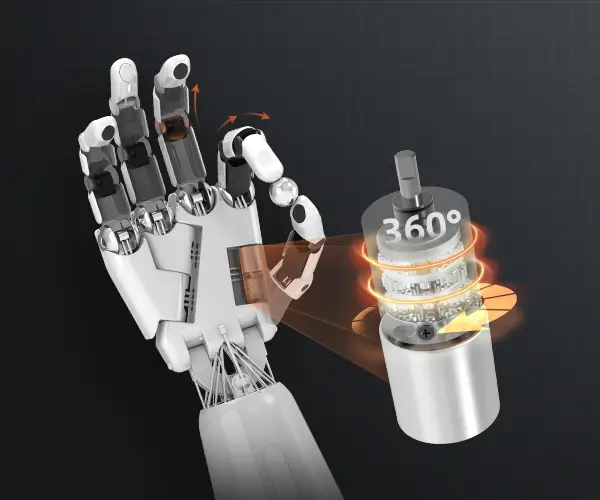Unlocking the Potential of 5V DC Gear Motors in Smart Robotics
In an era where robotics are pushing the boundaries of automation and intelligence, choosing the right components is pivotal. Among these, the 5V DC gear motor stands out as a tiny but mighty player—integral to the evolution of smart robots. Whether it’s a tiny drone, an autonomous vehicle, or a home assistant robot, the heart of movement and precision often beats with a small, reliable gear motor.

The Role of Gear Motors in Robotics
At its core, a gear motor combines a direct current (DC) motor with a gear train, a set of gears that reduces speed while increasing torque. This integration offers several key advantages for robotics:
Precision control: Gear motors allow for nuanced movement, essential for tasks such as object manipulation or delicate navigation. Torque amplification: The gear train boosts force output without needing larger motors, making designs compact and efficient. Energy efficiency: When properly selected, gear motors can operate effectively on low voltage supplies, reducing power consumption. Ease of integration: Small size and straightforward control interfaces make gear motors highly adaptable for various robotic platforms.
Why 5V? The Voltage Sweet Spot
The choice of 5V as the operating voltage for gear motors is no coincidence. It aligns perfectly with modern electronics and microcontroller systems like Arduino, Raspberry Pi, and other microcontroller boards, which commonly operate at or near 5V. This compatibility simplifies wiring, reduces power management complexities, and makes 5V gear motors ideal for compact, portable, and energy-efficient robot designs.
Beyond simplicity, 5V gear motors suit a range of applications:
Educational robots: Their affordability and ease of use make them popular among students and hobbyists. Miniature robots: Limited space and weight constraints demand small yet effective motors, which 5V gear motors readily provide. Sensor-driven systems: Many sensors and controllers operate at 5V, creating a natural interface for integrating gear motors into more complex setups.
Advantages of 5V DC Gear Motors
Compact Size: Their small footprint facilitates sleek robot designs. Whether building a walking bot or a robotic arm, these motors fit comfortably into confined spaces.
Cost-Effective: They are budget-friendly, making prototyping and experimentation accessible for startups, researchers, and educational initiatives.
Ease of Control: Many 5V gear motors can be driven with simple PWM (Pulse Width Modulation) signals and basic H-bridge drivers, allowing for precise speed and direction control.
Low Power Consumption: Designed to operate efficiently at 5V, they are perfect for battery-powered applications, extending operational time.
Versatility: Their widespread availability and variety in gear ratios mean they can be tailored to tasks ranging from fine movement to brute force.
Types of 5V DC Gear Motors
The landscape of 5V gear motors is rich with different configurations, each suited to specific tasks:
Planetary Gear Motors: Offer high torque in a compact form factor, excellent for demanding applications like lifting or pushing loads. Worm Gear Motors: Provide self-locking features, useful for holding position without continuous power. Spur Gear Motors: Simpler design, suitable for straightforward rotational tasks and cost-sensitive projects. Herringbone and Spiral Bevel Gear Motors: Designed for specific directional or speed requirements, often used in more specialized robots.
Applications in Modern Smart Robots
With their adaptability, 5V gear motors find countless roles:
Autonomous Vehicles: Small robots or drones depend on these motors for wheel movement and camera gimbal operation. Humanoid Robots: Fine motor control in limbs and facial expressions often involves tiny gear motors. Palmtop Robots: Micro-robots built for education or exploration rely on compact 5V gear motors. Home Automation Robots: Vacuum cleaners, lawn mowers, and cleaning bots harness these motors for mobility and task execution. Medical Robots: Precise actuation in miniature surgical or diagnostic robots often involves 5V gear motors.
Choosing the Right 5V Gear Motor
Selecting the appropriate motor depends on application-specific factors:
Torque Requirements: Calculate the load and choose a gear ratio that provides sufficient torque. Speed Specifications: Determine the desired rotational speed—gear ratios can be adjusted accordingly. Size Constraints: Ensure the motor fits within the robot’s design envelope. Power Budget: Confirm the motor’s voltage and current ratings align with your power source. Control Interface: Match the motor’s control type (digital, analog, PWM) with your microcontroller setup.
Designing Smarter Robots
Integrating 5V gear motors into robotic designs demands attention to detail. Incorporating sensors for feedback—such as encoders—allows for closed-loop control, improving accuracy and responsiveness. Advanced control algorithms, like PID (Proportional-Integral-Derivative), help smooth movements, especially in tasks requiring precision.
Moreover, coupling gear motors with microcontrollers can facilitate autonomous operation—enabling robots to navigate, manipulate objects, or perform complex tasks. The modular nature of these motors makes them perfect candidates for prototyping stages where flexibility is key.
Conclusion of Part 1
The humble 5V DC gear motor, while small, fuels a revolution in smart robotics—an enabler of ingenuity, efficiency, and compact design. Its compatibility with modern electronics, affordability, and versatility make it a cornerstone component for developers and enthusiasts alike. As robotics continue to evolve, these gear motors promise to stay at the heart of innovative, intelligent machines, bridging the gap between simple automation and genuine smart capabilities.
Established in 2005, Kpower has been dedicated to a professional compact motion unit manufacturer, headquartered in Dongguan, Guangdong Province, China.




































